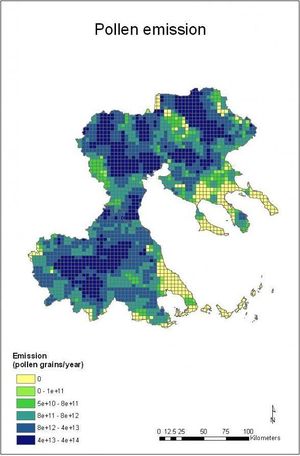Modelling contaminant releases: agriculture
- The text on this page is taken from an equivalent page of the IEHIAS-project.
As part of the EU-funded INTARESE project, which contribued to the development of this Toolbox, a case study was carried out to assess health impacts of agricultural land use change in Greece and England.
In both study areas, agricultural releases needed to be estimated of endotoxin, particulates,394 pesticides, and pollen as a basis for exposure estimation. The first of these derives mainly from livestock rearing; the other three are also produced by arable farming.
Estimates of emissions were modelled for a baseline and two policy scenarios for a regular grid covering each study area. A source grid of 4x4 km was used in Greece and a 5x5 km in [[IEHIAS mask area weighting: example for pesticides|England]. Grids were constructed for all the relevant source activities, including area of specific crops, number of animals (i.e. head or livestock unit), and amount of pesticide active ingredients per grid cell.
For each grid cell, the emissions are calculated as the product of the agricultural activity and the source-specific emission factor, using the basic formula:
R = S * F
where, R is the release rate (volume/time), S is the level of source activity (/time) and F is the emission factor (volume/unit of activity).
Endotoxin
Annual emission grids for respirable and inhalable endotoxin were computed on the basis of specific livestock units and endotoxin emission factors.
In this case:
- S is the livestock count in grid cell (e.g. head/25 km2)
- F is the EF for specific livestock units (e.g. µg/head)
Particulates
Annual particulate emission grids were computed as the sum of emissions from individual crop and livestock sources for which PM emission factors were compiled.
For crops:
- S is the area of specific crop in grid cell (e.g. ha/25 km2)
- F is the EF for specific crops (e.g. kg/ha)
For livestock:
- S is the livestock count in grid cell (e.g. head/25 km2)
- F is the EF for specific livestock units (e.g. kg/head)
Pesticides
Annual emission grids were computed for each active ingredient (AI) using pesticide eission factors taken from a Dutch study.
Here:
- S is amount of individual pesticide active ingredient in grid cell (e.g. kg/25 km2)
- F is the EF for individual AIs (e.g. g /g air)
Pollen

Pollen emission grids were computed as the sum of emissions from individual crops using modelled pollen emission factors. The pollen EFs are representative of the duration for typical pollen shedding (e.g one month for maize).
Here:
- S is the area of specific crop in grid cell (e.g. ha/25 km2)
- F is the EF for specific crops (e.g. grains/ha/month)
Figure 1 shows an example of the resulting emission grids, for pollen emissions in Thessaly and Central Macedonia, in Greece.
See also
In the agricultural case study, the emissions grids described here were used as input data for further modelling. Two different approaches were explored to generate concentration grids. Maps of emission for several of the agricultural contaminants are also shown in the first example: